Flower jelly is an easy way to capture the flavor of fresh edible blossoms for year-round enjoyment.

I make literally dozens of types of jam and jelly each year, but the flower jellies are always my daughter’s favorite. She just finds magic edible flowers, and I can’t blame her, they are pretty special.
While I’ll occasionally get a few complaints about harvesting gallons of blueberries for blueberry jam (or plain canned blueberries), I get nothing but smiles and excitement when it’s time to harvest a basket of flowers for floral jelly.
Skipping around in sandals and a unicorn dress, my little one is in heaven harvesting flowers for jelly. And there’s something about her excitement that makes me want to make batch after batch, sampling every blossom in the yard.
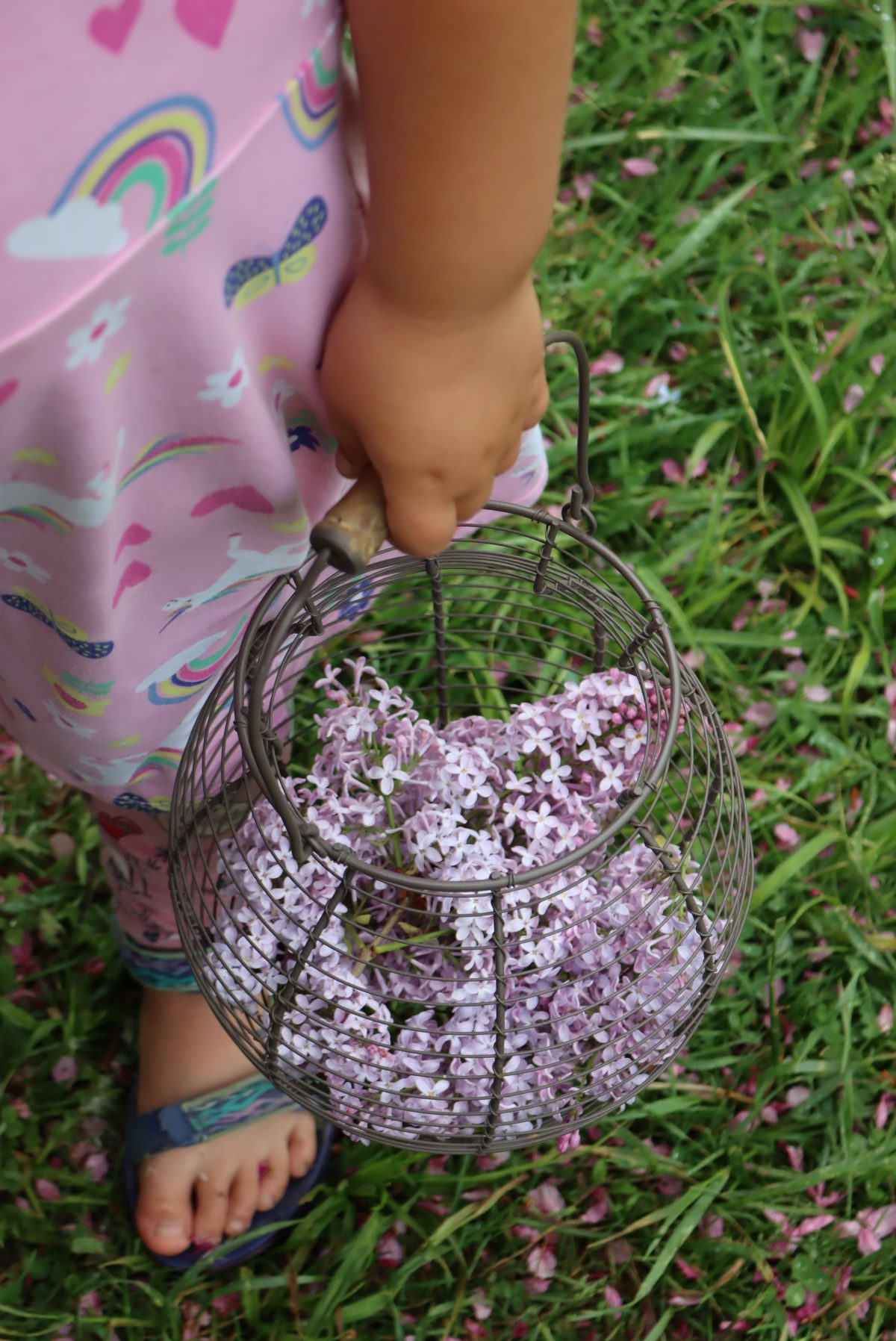
My daughter with a basket of lilacs for lilac jelly.
Edible Flower Safety
Please be sure that the blossoms you use for jelly are in fact edible flowers, as not all flowers are edible varieties. Only used unsprayed flowers (no herbicides of pesticides) that were harvested from clean locations (ie. not roadsides or drainage ditches).
Beyond that, it’s always possible to have a reaction to new foods, so please be careful when making big batches of things you’ve never tried before.
If foraging wild blossoms, always be 100% sure of your identification before trying any wild plant.
Many flowers are medicinal as well as edible, and while the quantities used in jelly generally aren’t considered a “therapeutic dose,” be sure that their actions don’t conflict with any health conditions you may have. For example, hawthorn blossoms are used in blood pressure preparations, and violet blossoms are mildly diuretic.
Do a bit of background research on the particular blossom you’ve chosen.
Basic Floral Jelly Recipe
The basic recipe for flower jellies is more or less the same, regardless of the type of flower used. It’s true that each flower has its own unique flavor, color, and character, but the basic process of making floral jelly doesn’t change.
Of course, you can always add other spices or seasonings, and perhaps fruit juice to the jelly, but the process is still the same no matter how you customize it.
Start by harvesting 3 to 4 cups of flower petals. For most flowers, you just want the petals rather than the whole flower structure. That means harvesting a bit more of flowers like dandelions, which are about half greens and stem when the blossoms are plucked.
Clean the flowers, removing any debris and anything that’s not a fragrant flower petal, and be sure you have roughly a quart of material. I generally just measure them into a quart mason jar, as it’s a convenient measure and since it’s heatproof, it works well with the next step which is making blossom tea.
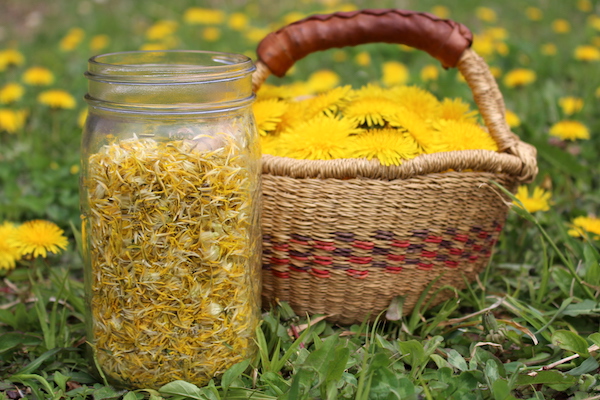
Harvesting flowers for dandelion jelly. The flowers must be cleaned and separated since you only use the yellow petals for jelly.
Once you have about a quart of cleaned petals, pour boiling water over the top of the petals and allow them to infuse into a floral tea.
While the water is extracting flavor, it’s also extracting color and some flowers put out pretty surprising colors. Bee balm makes a bright red floral tea, as you’d expect.
Flowers like lilacs and violets, on the other hand, make turquoise tea even though they’re pink or purple. Don’t worry, that’s just the water extracting some of the antioxidants from the petals, which are similar to the color compounds in blueberries and blackberries.
When you add lemon juice (or just pectin because it contains citric acid), the color will change to a vibrant pink/purple.

Violet tea changes from a blue/green color to a vibrant pink/purple with the addition of lemon juice. Starting at top left, when the first lemon juice is added, and then continuing until all the acid has been added.
Generally, most flower jelly recipes will add 2 tablespoons of lemon juice for every 4 cups of floral tea. Some add a bit more, like violet jelly, both to help with color and to bring out the natural flavors in the flowers. Violets taste a lot like spring berries and the extra lemon juice adds a tartness that accentuates their berry flavor.
For the most part, go with 2 tablespoons of lemon juice for a batch.
Strain the flowers and add the floral tea and lemon juice to a saucepan or jam pot. Bring the mixture to a boil and add a box of pectin.
I generally use sure jell or sure jell low sugar pectin, as they’re really dependable and result in the best texture in my opinion. (I’ve tried just about every type of pectin on the market.)
For regular sure jell pectin, you’ll need to add a minimum of 4 cups of sugar because it’ll only jell with a 1:1 liquid to sugar ratio. Sure jell low sugar will gel with any amount of sugar, and you can use as little as 1/2 cup for a barely sweet jelly. I’d suggest using 1 to 2 cups for a lower-sugar recipe that’s still sweet enough.
(Sure jell low sugar can also be used with full sugar recipes, so that’s what I usually keep on my shelf because it works great regardless of the sugar you choose.)
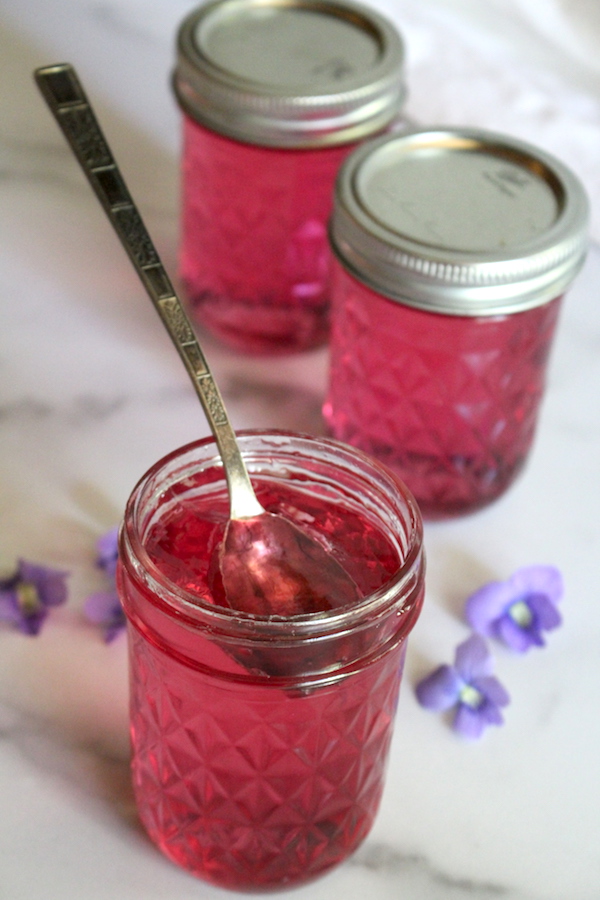
Homemade violet jelly is thick enough to hold a spoon, but smooth and spreadable on toast and scones.
Allow the flower tea, lemon juice, and pectin to boil for 1 full minute before adding any sugar.
This is important!
If you add the sugar from the start, the pectin will denature and the jelly will not set. The pectin must be incorporated and boiled for 1 minute before the sugar is added. This is one of the most common reasons for a jelly that just won’t set.
(The second most common reason is overcooking, such as boiling longer than 5 minutes, and the 3rd common failure mode is large batch size. Stick the recipe and don’t try to double, and don’t boil too long, for best results.)
Once the jelly has boiled for 1 minute, add the sugar and stir to incorporate. Allow the mixture to return to a boil and boil for 1 full minute before ladling into jelly jars leaving 1/4 inch headspace.
A standard “batch” will yield about 5 half-pints (8 oz) jars if you use full sugar (4 cups). The yield is slightly less if you use a lower amount of sugar.
Canning is optional, but if you choose to can flower jelly, process the jars in a water bath canner for 10 minutes.
If not canning, let the jars cool to room temperature on the counter and then store in the refrigerator (for up to a month) or freezer (for up to 6 months). If freezing, be sure to use straight-sided freezer-safe jars.
Floral Jelly Recipes
Using the basic floral jelly recipe above, you can make jelly out of almost any edible flower. Be sure to remove the sepals, stems, and any green parts as they can sometimes impart a bitter flavor to floral jellies.
Sometimes recipes other ingredients to bring out or compliment specific flavors within the flowers themselves. Nasturtium jelly (recipe coming soon), for example, is sometimes made with a few Sichuan peppercorns added to the infusion, as they have a similar spicy flavor.
Complimentary herbs, spices of flavorings can also help to round out a herbal jelly, as in this nasturtium apple mint jelly.
Whether you choose to follow the basic recipe or experiment on your own, the choice is up to you. Either way, here are some of the tastiest floral jellies around to inspire your creative side…
Dandelion Jelly tastes like honey and has a natural bright yellow color that adds a sunny touch to your morning toast. Dandelion syrup, or basically dandelion jelly without the pectin, is used as a vegan honey substitute because the flavor is so convincing.
It’s one of my daughter’s absolute favorites, and it has a light and floral with just a hint of honey that’s delightful (without being overwhelming).
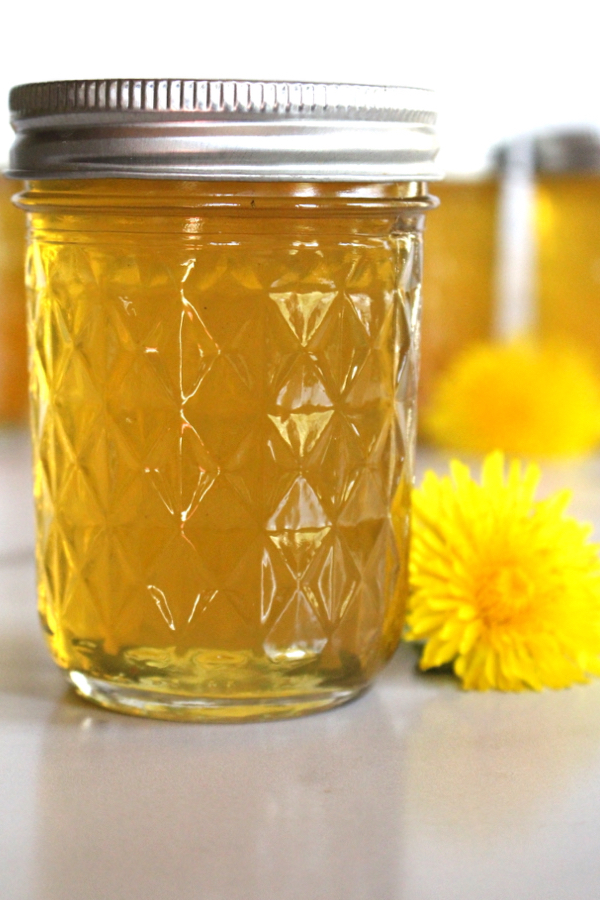
Wild Violet Jelly has an amazing magenta color that only comes out when lemon juice (or citric acid) is added. An infusion of their petals makes a bright teal, and which then turns magenta (pinkish purple) when the acid source is added.
While the color is beautiful, the flavor is even better. Believe it or not, violet jelly tastes like fresh spring berries!
The flavor is light and floral, but there are definitely berry notes there too. Think blueberry and black raspberry.

Lilac jelly is definitely the most “floral” flower jelly that I’ve made to date, and the flavor is exactly that of fresh lilacs on the spring breeze.
It’s going to taste amazing this winter, after months of nothing but snow, I’m going to pull out this little jar of spring on a sunny Sunday morning.
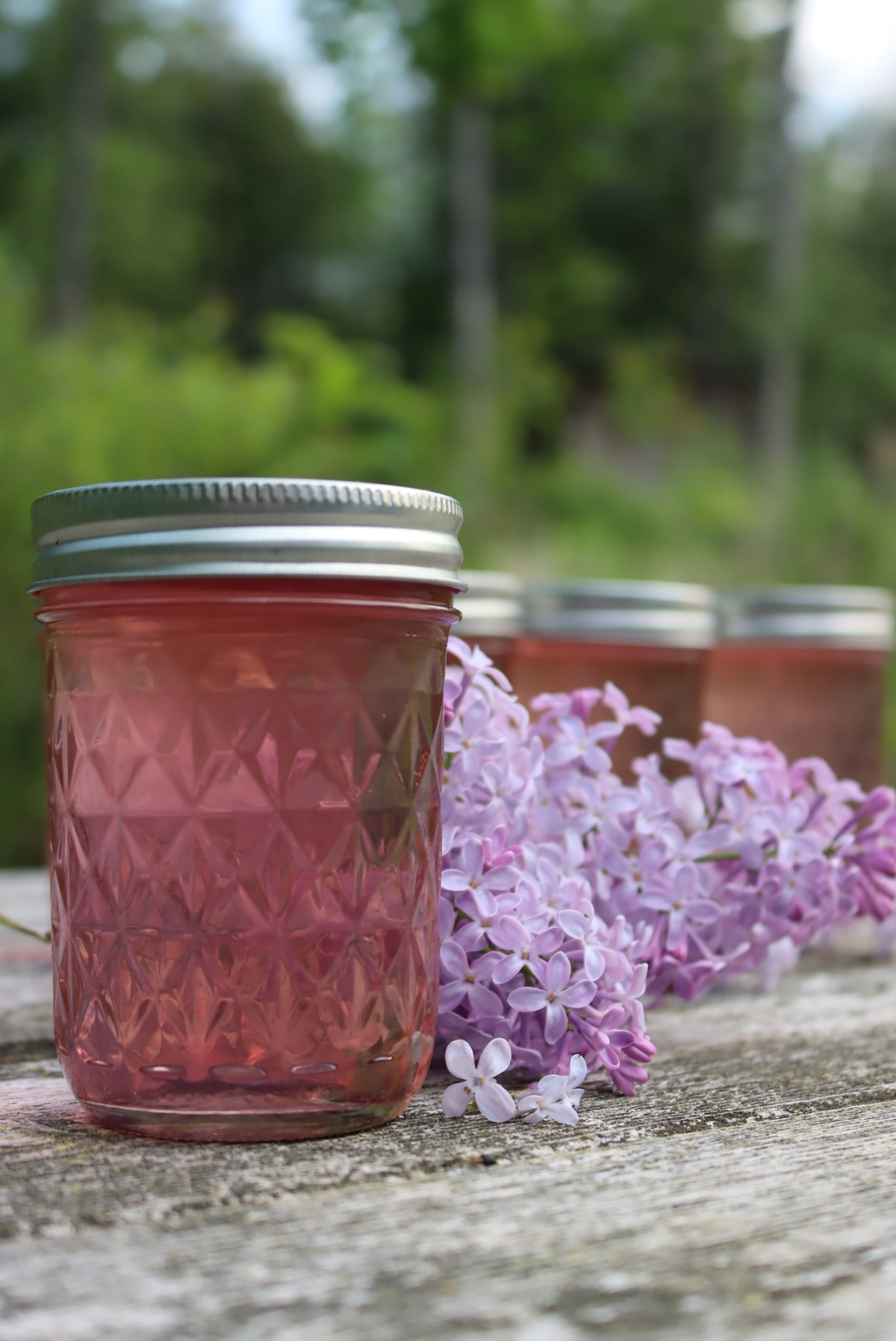
Bee balm jelly is really unique and has a more savory character than some of the others. Sure, it’s still a sweet jelly full of plenty of sugar, but it’s more “herbal” than it is floral in my opinion.
That’s possible because bee balm (monarda sp.) is actually used in Mediterranean cooking as a seasoning similar to oregano, and though it’s usually the leaves used in savory dishes, the blossoms have a milder herbal character.
The bright red color is stunning in any case!
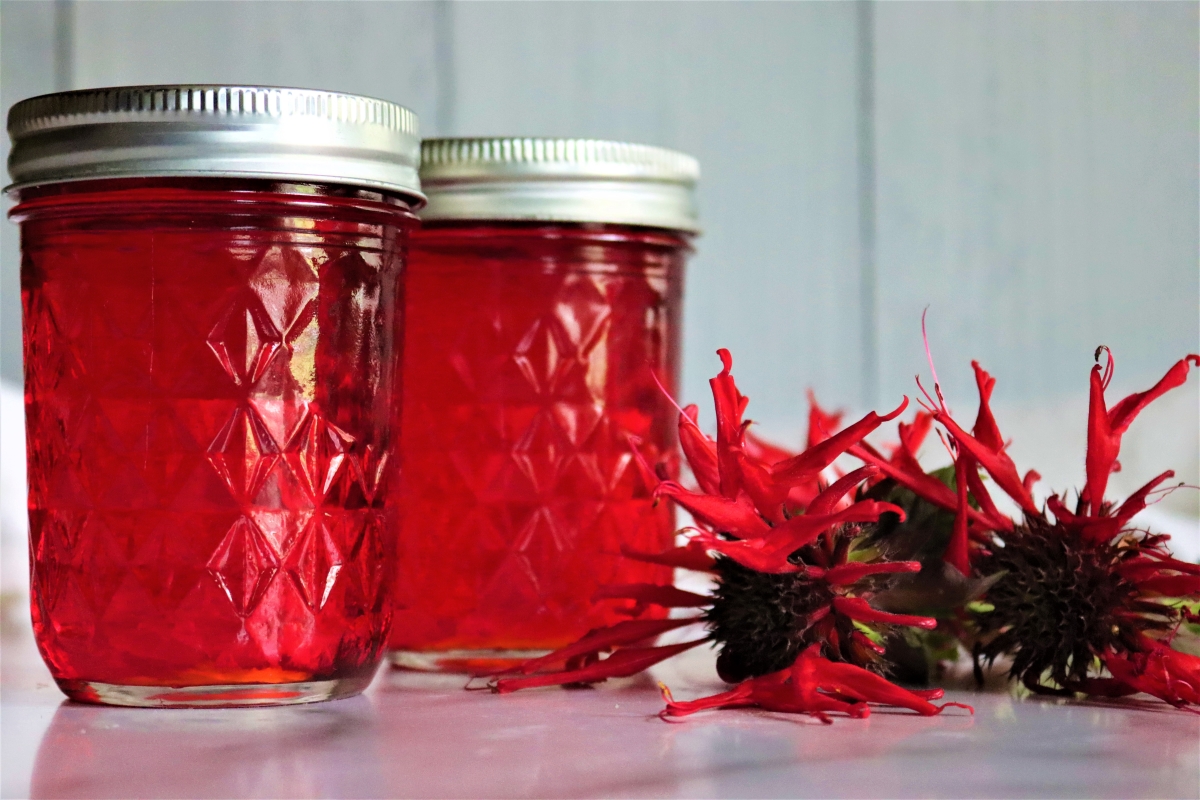
Fireweed jelly is a wild foraged treat, and you can only make it in places where fireweed grows wild. That said, fireweed (also known as rose willow herb) is pretty common and loves disturbed areas in much the same way as dandelions.
As the name suggests, it colonizes burned sites readily, but also areas after floods and other natural (or man-made) disturbances.
As with any wild plant, make sure you properly identify it before eating the tasty blossoms as jelly.

Beyond my favorites, there are plenty more options, including:
- Apple Blossom Jelly
- Black Locust Jelly
- Borage Jelly
- Chamomile Jelly
- Clover Blossom Jelly
- Daylily Jelly ~ Skirt in the Kitchen
- Elderflower Jelly
- Forsythia Jelly
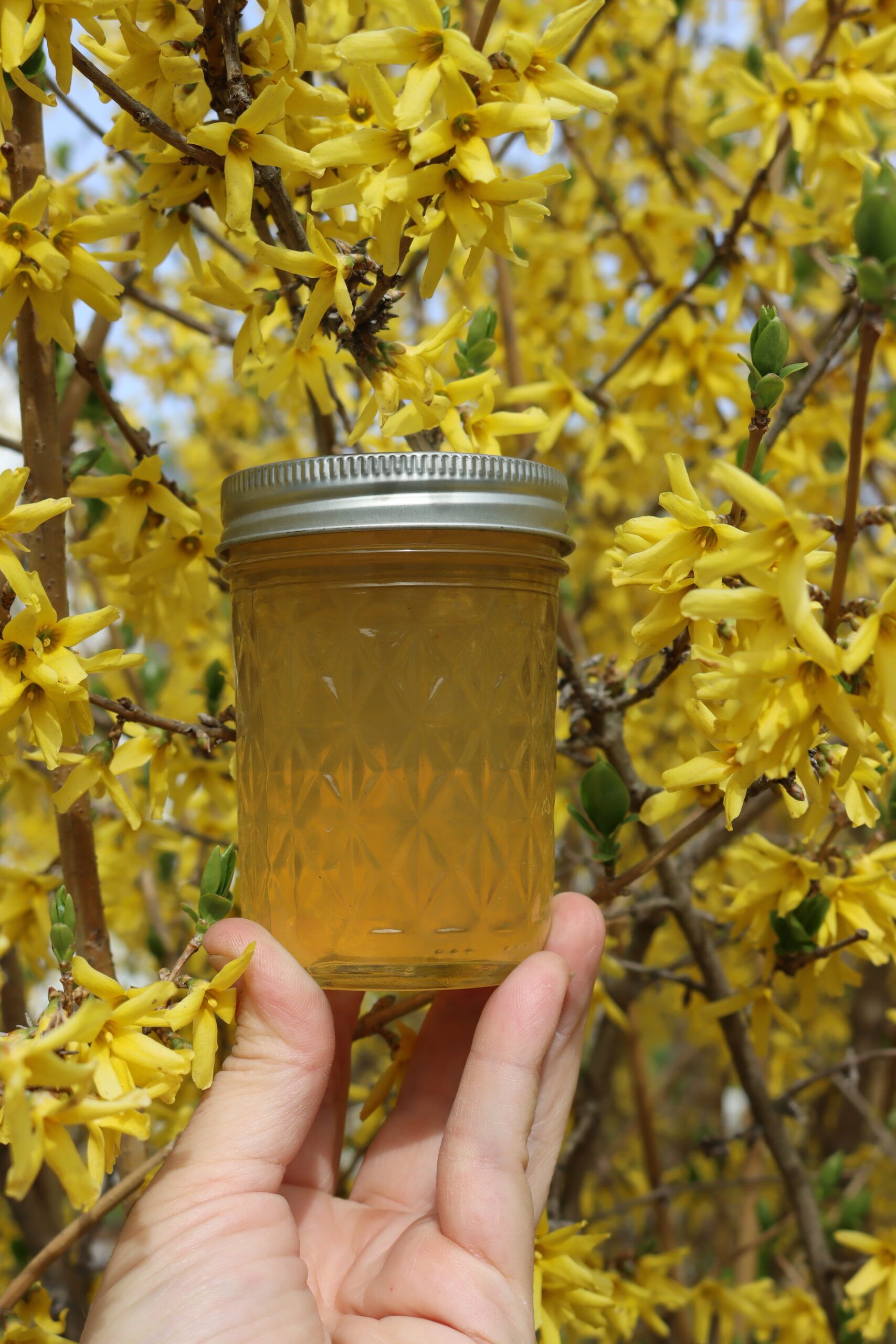
Forsythia jelly
- Hibiscus Jelly ~ What Julia Ate
- Honeysuckle Jelly ~ Rootsy
- Kudzu Blossom Jelly ~ Edible Communities
- Lavender Jelly ~ What’s Cooking America
- Milkweed Jelly ~ Backyard Forager
- Pansy Jelly
- Peony Jelly
- Rose Petal Jelly
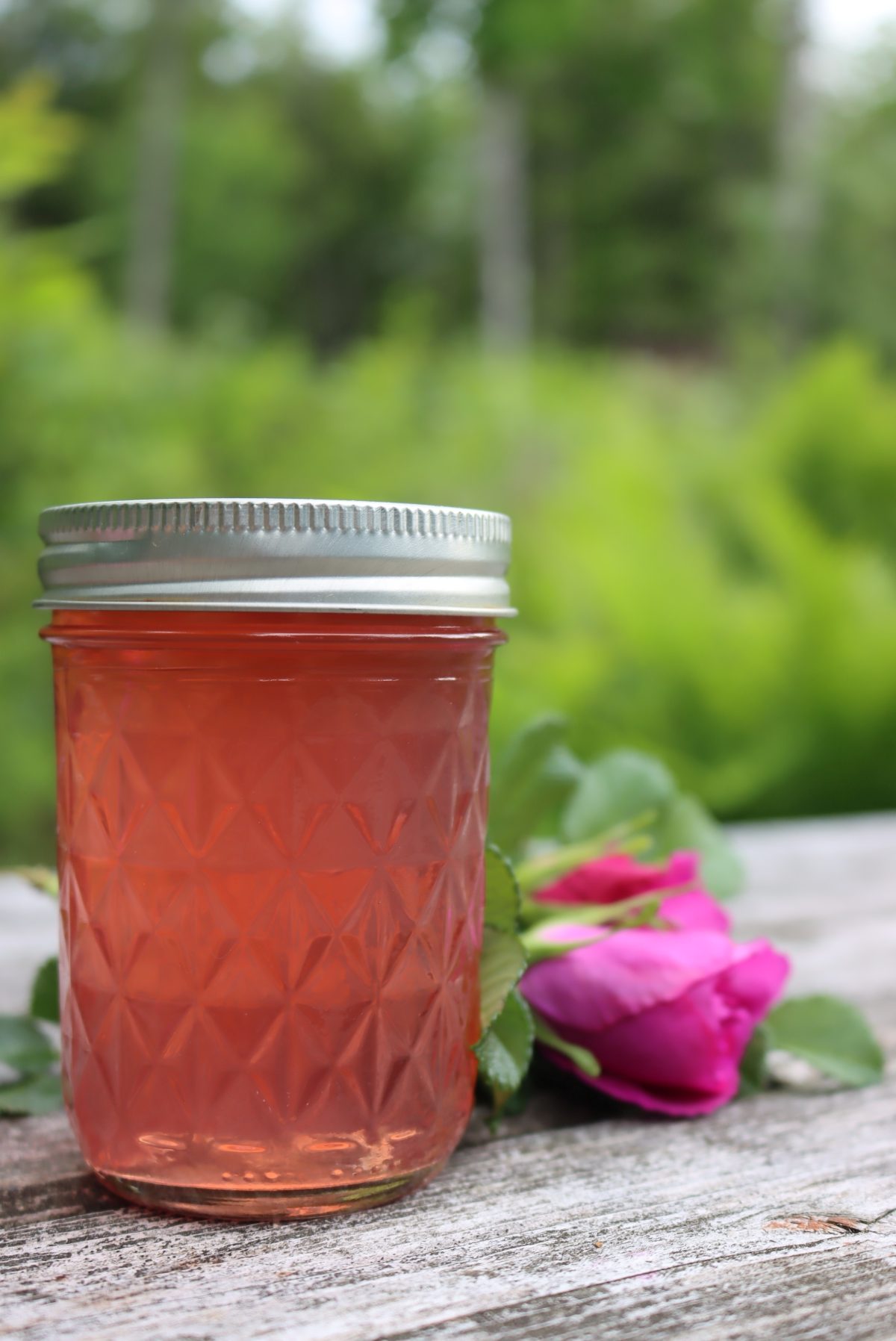
Rose Petal Jelly
Floral Jams
Some recipes actually include flower petals in the jelly and call themselves “floral jam” as a result. A good example is rose jam, which is absolutely unbelievable.
The rose petals stay soft and supple even when cooked, and add beautiful color (and just enough texture) to the finished jam.
Not all flowers make good jams, and most are best strained out after they’ve imparted their flavor. That said, these are particularly good, and either use whole petals or flower petals processed in a food processor before they’re added to the flower jam:
- Rose Petal Jam ~ Feasting at Home
- Johnny Jump Up Jam ~ Blooming Glen Farm
- Hibiscus Jam ~ Garden Girl Cooks
Herbal Preserves
Beyond simple flower jellies, you can also add edible flowers to fruit preserves as well. Blueberry lavender is a classic combination, but there are many others.
Try any of these tasty floral-infused fruit jam recipes:
- Blueberry Lavender Jam ~ Serious Eats
- Strawberry Elderflower Jam ~ Fab Food 4 All
- Roasted Strawberry Chamomile Jelly ~ Ball Fresh Preserving
- Daylily Citrus Jelly ~ Skirt in the Kitchen
- Peach Lavender Jam ~ Love and Olive Oil
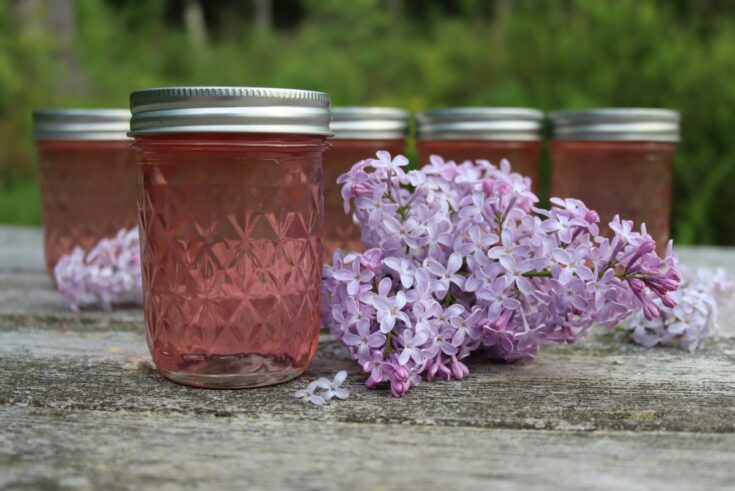
Flower Jelly
Flower jellies capture the flavor of fresh blossoms in a sweet floral jelly.
Ingredients
- 4 cups edible flower blossoms
- 4 cups water
- 2 tbsp lemon juice
- 1 to 4 cups sugar *see note
- 1 box (1.75 oz) pectin (Regular or Low Sugar)
Instructions
- Separate 4 cups of edible flower blossoms from their stems, carefully removing any green parts.
- Pour 4 cups boiling water over the top of the flower blossoms and allow the tea to infuse for about 10 minutes.
- Strain the floral tea into a saucepan or jam pot. Add the lemon juice, which will help bring out the best color in the jelly, but it's also required to balance the sugar in the recipe and help the pectin set. Beyond that, it adds acidity to help preserve the jelly, so don't skip the lemon!
- Bring the mixture to a boil and add the powdered pectin, stirring to dissolve. Allow the mixture to boil for 1 minute before adding sugar. (Note: Do not add the sugar at the same time as the pectin, or before the pectin, or the jell will not set.)
- Add the sugar, stirring to dissolve (See notes on quantity). Bring the mixture back to a full boil for 1 minute before ladling into jelly jars leaving 1/4 inch headspace.
- If canning, process in a water bath canner for 10 minutes. Otherwise, allow the jars to cool completely on the counter before storing in the refrigerator (for up to a month) or the freezer for up to 6 months.
Notes
Please be sure that the blossoms you use for jelly are, in fact, edible flowers, as not all flowers are edible varieties. Only used unsprayed flowers (no herbicides or pesticides) that were harvested from clean locations (ie. not roadsides or drainage ditches).
Beyond that, it's always possible to react to new foods, so please be careful when making big batches of things you've never tried before.
Many flowers are medicinal as well as edible, and while the quantities used in jelly generally aren't considered a "therapeutic dose," be sure that their actions don't conflict with any health conditions you may have. For example, hawthorn blossoms are used in blood pressure preparations, and violet blossoms are mildly diuretic.
Do a bit of background research on the particular blossom you've chosen.
A note on sugar...
If using standard pectin, you must use a 1:1 ratio of liquid to sugar. That means for 4 cups flower blossom tea you'd need a minimum of 4 cups sugar to get the jelly to set. That results in a very sweet "old-fashioned" jelly. To reduce the sugar, simply use low-sugar pectin instead and then make the jelly as instructed but using less sugar. I suggest sure jel low sugar, which is very dependable.
Lowering sugar will also lower yield, and the yield of 5 half-pints is for a full sugar recipe.
If using Pomona's Universal Pectin, the instructions are different as that is a 2-part low sugar pectin, with pectin powder and calcium water as an activator. Most pectins include citric acid to help drop the pH, but Pomona's doesn't. If you're using Pomona's for a floral jelly, you'll need to increase the lemon juice to 1/2 cup (from 2 Tbsp). Follow the instructions provided in the Pomona's box for mint jelly.
If using liquid pectin, the order of operations is different (pectin is added last, sugar first). Liquid pectin also requires a lot more sugar to set (7 cups sugar to 4 cups liquid). I don't recommend liquid pectin because of the high sugar levels required for set, but it will work if that's your preference.
Edible Flower Recipes
Looking for more ways to enjoy edible flowers?
- Rose Cordial
- Elderflower Cordial
- Lilac Wine
- Dandelion and Honey Ice Cream
- Dandelion Shortbread Cookies
Edible Flower Guides
These recipe roundups each have dozens of ways to eat edible flowers:
- 60+ Dandelion Recipes
- 60+ Nasturtium Recipes
- 15+ Ways to Use Borage
- How to Eat a Rose (Rose Recipes)
- How to Eat Lilacs (Lilac Recipes)
- How to Eat a Peony (Peony Recipes)
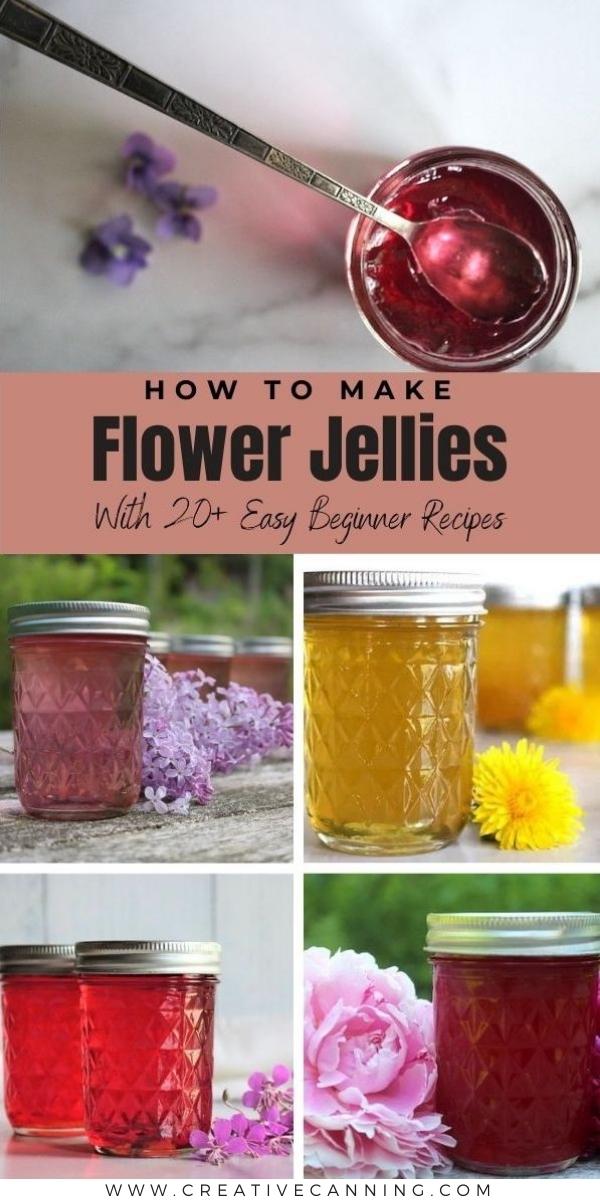
Camilla Hawkins
Loving all these pretty jellies! Thank you for sharing my Strawberry & Elderflower Jam:-)
Michelle
Is dianthus a good flower to use for jelly?
Administrator
I haven’t tried it but I would be interested to know how it works out if you decide to try it.
Michelle
I’m mixing dianthus, marigold, hibiscus and some dandelion to make a mixed flower jelly..
Administrator
That sounds so fun. I can’t wait to hear how it turns out.
Dana
I have used your recipe for wild violet jelly and it came out perfect! I have not tried the dandelion jelly yet, as our cop this past spring went into dandelion wine instead, but I intend to try it next spring. I have a couple of questions about other jellies, though, that I hope you can help me with.
Hibiscus Jelly: Any particular variety or color that does better than others? We have a white hardy hibiscus that puts out HUGE blossoms, but don’t have a red hibiscus. Will the white do, and will it have much color at all in the final jelly? There’s also a tropical hibiscus with showier blossoms, but they don’t survive winter here in Kentucky. Does it matter which you use? Are they both edible?
Mint jelly: As usual, our mint is exploding about this time of year, and I would like to make mint jelly. Can I use this same basic recipe substituting mint leaves for flower petals? Does this also need lemon juice to set properly?
Sugar vs Splenda: I am pre-diabetic, and my doctor wants me to avoid sugar. I have a bag of Splenda for Baking, which is supposed to measure 1 for 1 instead of sugar. It works great for cobblers, etc. Can it be used instead of sugar in jelly making if I use the low-sugar pectin?
Thanks for any information you have on these kind of left-field questions!
Administrator
If the hibiscus is white, it will most likely not have much color in the finished product. It is very important to know exactly which variety of hibiscus you have and then do your research to be sure that your variety is edible. If it is edible then the only way to know how it will taste is to just experiment and try it. You can definitely try this recipe with mint and use the lemon juice since like flowers, the herbs do not have the natural pectin that many fruits have. I actually found this recipe from Pomona Pectin for a mint jelly that you might want to try. It uses honey. https://pomonapectin.com/mint-lemon-jelly-with-honey/ I know that Splenda can typically be used with Pomona but you might want to check with them directly for this specific recipe.
Tess Cass
I love creating and making things for those I love. Im making jellies as Christmas gifts this year.
Do you know if Oxblood Lilies are edible?
Administrator
I am not familiar with anyone using the oxblood lily for food. I tried to do a quick search and wasn’t able to find any information one way or the other. If you find something on this let us know.
Tess
As of yet I have still not found anything. I will keep searching and asking.
Michele Ray
I didn’t see anything about whether the pollen needs to be removed… does it make a difference?
Administrator
For most of the floral jellies, you want to use just the flower petal and not the entire flower structure.
Michele Ray
Thanks so much! I’m helping a friend with her saffron harvest and am going to try this with the petals!
Administrator
That’s interesting. I haven’t heard of using the petals before. Are they edible?
Michele Ray
They *are* edible! And they smell amazing, too! I found an article about them, if you are interested:
https://www.ncbi.nlm.nih.gov/pmc/articles/PMC6251391/
Apart from Saffron Crocus SPECIFICALLY, autumn crocus are definitely toxic, so people should NOT experiment with any other kind!
Administrator
That’s great! Thanks for sharing.
Josie
Accidentally came across this article and wow!! such great info and so well done adding in the details that most online recipes leave out. Brilliant. And thanks!!
Administrator
You’re welcome. I’m so glad you enjoyed it.
Marci
This post was an inspiration to me. I had never realized that flower petals could be made into jelly, but the beautiful and delicious rose/poppy jelly I made last summer using your formula was a treat! I’m looking forward to making more this summer, and also turning some leaves from my wild mint into mint jelly. (I haven’t been able to find mint jelly made without HFCS, much less organic mint jelly, so it’s been decades since I’ve been able to enjoy mint jelly with my pasture raised lamb.) Thank you so much for this revelation.
Administrator
You’re so very welcome. We’re so glad that you enjoyed the jelly formula and are able to now enjoy your mint jelly again.
Sarah
Could I freeze the tea and make the jelly at a later date? How long do you think it can be frozen without losing flavor? Thanks.
Administrator
Yes, you can do this. I’m not sure how long you could freeze it for, but I would say it could be frozen for quite a while.
Jan
I have blu butterfly pea growing in my yard. It makes a wonderfly tea. Do you think it would make a good jelly?
Administrator
Yes, I definitely think it would. Let us know how it turns out.
Jenen
I followed your recipe last year and made dandelion jelly and rose jelly, my kids especially loved it. This year I’m excited to try violet jelly and maybe a lower sugar option.
I do have a question that I struggled with a little last year. When you make the petal tea, and strain the tea into your pot, I never end up with the full 4 cups of water. Should I be making more? Or is this the intention and it’s still best to add 4 cups of sugar? Or maybe I’m packing my petals too tightly? I look forward to your thoughts and guidance.
Thanks!
Administrator
You can add a little bit more water in the beginning and then pour off any extra or you could also add a little bit of water to make the 4 cups after brewing if you need to.
Robin Houseworth
Can you make jelly using the mint flowers?
Ashley Adamant
Yes, indeed you can. You can also make it with mint leaves too, using the same recipe.
Deb
Can I make lemon balm jelly?
Ashley Adamant
Yup, that’d be delicious!
Maura
It IS delicious! I just canned my first batch this year. You can even use dried leaves to make the “tea”. Just taste test it before making the final jelly. Dried herbs tend to have a stronger flavor and you may need to use less.
C
would like to try recipes on this post especially rose jam but I can’t find any edible flowers online.
Ashley Adamant
Take a look at mountain rose herbs or starwest botanicals, they’re both good sources.
Kristin
Could you make jelly with dried flowers? If so how many cups of dried blossoms would you steep?
Ashley Adamant
Yes, just be sure they’re completely unsprayed, as some commercially produced dried flowers are heavily treated with preservatives. If you’re buying them, make sure they’re food-grade. Give them a smell too, as some flowers lose their scent (and flavor) when dried. But if they’re clean, unsprayed edible flower varieties and smell good, then yes! You’d use about half as much dried blossoms as you would fresh. (So 2 cups in a recipe that says 4 cups)
Joy
I love this post!! It has inspired so many ides!! I have tried the violet jelly and it was wonderful. I intend to try the peony recipe when they begin to bloom.
Inspired by the recipes, I wonder if I could use wild cherry blossoms.We have a wild cherry growing on our property and the blooms are so pretty, I thought they might make a beautiful jelly!??
Ashley Adamant
Yes, that should work wonderfully! We have a very fragrant crabapple that I’m going to use this year too. Anything edible and fragrant works.
Sue Archer
I’m getting ready to make Redbud Jelly this year. I tried some from a friend last year and it is amazing.
Nonarae
Do you think this would work with herbal teas? I really LOVE celestial seasonings zinger teas, and I think they’d be delicious as jellies!
Ashley Adamant
Yup, that’d work wonderfully!
Susan Wright
I just made violet jelly and dandelion jelly. The first batch of dandelion jelly did not set up, but I used a different recipe. When I used your recipe, it worked every time. I am so excited. This is my first experience with canning of any sort.
Ashley Adamant
Wonderful! The sure jel low sugar pectin type is incredibly dependable, provided you add things in the right order. I’ve had less success with other types of pectin, so this that’s my go to now. I’m so glad it worked for you!
Brandi
We made the lilac jelly and it is very bitter, almost chokecherry level. We added 6 cups of sugar to make it edible. Any idea what went wrong?
Ashley Adamant
Did you remove the little green parts at the base of each flower? Those are very bitter and you really have to use just the petals. With just the petals it’s not bitter at all, but with all flower jellies you really need just the petals.
Audrey Ray
Can wild sweet pea flowers be used to make jelly ?
Ashley Adamant
A quick google search says that sweet pea plants and flowers are not edible. You can make jelly with any edible flower, but not ones that are not edible. (I don’t grow sweet peas, and I don’t know much about them. I’m relying on google here to tell me whether they’re eidble or not, so if you find different information, do let me know.)
Jennifer
Life got busy and my pedals have been steeping for a few days – are they still good to use?
Ashley Adamant
On the counter at room temperature, they may have gone off, but if you had it in the refrigerator, they’re likely still good.
Debra Haynes
I now know why my fireweed tea is bitter. Is there any way to fix it before making jelly or should I just start over?
Ashley Adamant
If it’s bitter, there’s no real way to make it better. You’ve got to start over, sorry to say.
Barlow
I’ve made dandelion jelly, and pear blossom, and now henbit. Do the petals always turn brown when you pour the water over them?
Ashley Adamant
Hmmm…in my case, they’ve always either not changed, or turned white as their color went out into the flower tea in the infusion. Is your finished jelly brown, or just he flower petals that you’re straining out?
JOYCE WARD
Why is Gardenia jelly not mentioned in your article? I wanted to try it since I have three large bushes in flower now. Is it not good in jellies?
Ashley Adamant
I’ve never grown those (or eaten them) so it didn’t occur to me. A quick google search says they’re an edible flower, so they should be fine. Let me know how it goes!
Misty Fincher
Hello, I just found out that all parts of the crepe myrtle are edible. Could I use the flowers to make a jelly? I’ve searched online and know you can make tee. Etc but no mention of recipes. And could I use dried hibiscus flowers fir jelly? Thank you for any help.
Ashley Adamant
I’m actually not familiar with crepe myrtle, but in theory, this recipe works with any edible flower.